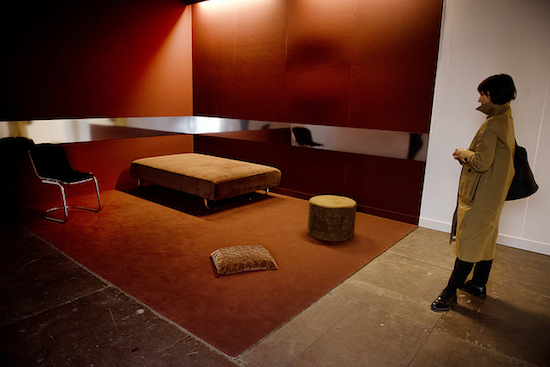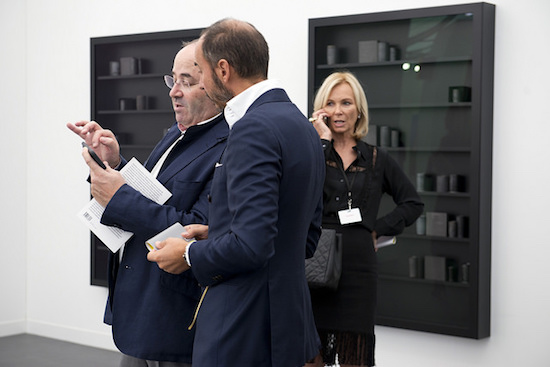“… Contemporary art has become so intellectual. That’s why performance art is appealing. Because it involves people.” As I hear these words – from what stranger’s mouth, I know not – I’m watching two dancers in tight tan-coloured outfits glide serenely across bright blue conveyor belts to a soundtrack of heaving bass drones and stuttered pink noise. The music is by Mira Calix, the choreography by Mbulelo Ndabeni and Fukiko Takase, with the artist Goshka Macuga.
I’m watching it all through the screens of mobile phones held aloft by other strangers. It’s so crowded here in that any hope of actual first-hand spectatorship is practically impossible. The tight scrum of the David Roberts Art Foundation’s annual Night of Performance has become something of a Frieze Week tradition. It’s all-star cast of contemporary art players squeezes a queue that trailed down Camden High Street into the narrow galleries of the DRAF for three hours of live art followed by a DJ set by one half of electropop duo The Knife. It involves people. Hundreds of them.
The following day I find myself caught up in a procession wearing laurel wreaths traipsing along the Regents Canal for an event called Pompe. As we traverse the slender towpaths, our journey leads us past masked dance troupes smashing their faces into sponge cakes, operatic tenors singing in the underpath, bridal-gowned cupids firing arrows from the prow of a narrowboat, and two composers – Neil Luck and Adam de la Cour – stuttering and tap dancing their way through the plot of Don’t Look Now. Wearing cloaks.
I don’t know if it’s just me or ‘a thing’, but this year I found Frieze to be all about performance. Upon first arriving at the fair proper, on Wednesday evening, one of the first things that struck me was a work by Christine Sun Kim featuring a septet in chroma key green tracksuits executing a series of mundane sounding gestures – moving chairs, dropping things in bins, placing cutlery on a plate – in choreographed synchronicity. Nap Disturbance is a mini-opera about the deaf experience of sound, about sound as both a material thing and a social weight that is exercised through a complex micropolitics of discipline and self-management that only in limit cases – such as the experience of deafness – becomes overt.
A little later, from a corridor in the fair’s far west wing, I was ushered into a small room in which two actors performed a brief dystopian sci-fi skit inside a futuristic MDF facility in stark white and pastel pink. As they mooned and moaned listlessly about this little domestic environment of tomorrow, playing solo pingpong and knocking back protein supplements, the cast were watched over by a quartet of anthropomorphic robots, optimistic slogans in wooden frames, and a little pink Buddha. Wonderland Ave. by Sibylle Berg and Claus Richter made an odd little spectacle, equal parts THX 1138 and Red Dwarf. But somehow it’s sense of an over-lit holiday camp ruled by animatronic robots stayed with me as I continued to stalk the aisles of the fair.

Photograph by Lewis Ronald. Courtesy of Lewis Ronald/Frieze.
For many of the artists exhibiting this year, the actual performance itself has become superfluous. Better to simply present a carefully-wrought stage set. That way, the messy business of performing can be left to the spectators themselves – many of whom, dressed in Matrix-y costumes of vantablack and obtuse angles, were only too happy to oblige. Los Angeles gallery Kayne Griffin Corcoran dedicated a walled-off enclosure to James Turrell’s Stewart Island(2015), an empty white room bearing just a single glass ellipse on one wall, behind which a constantly changing LED light subtly activates the room in an ever-shifting and possibly mood-altering kaleidoscope of blues and pinks.
Marianne Boesky Gallery is presenting an entirely white-washed room by Belgian artist Hans op de Beeck, complete with bleached-out people and an all-white landscape on the wall. London gallery Carlos/Ishikawa have seen their booth transformed into a high street internet cafe by artist group Lloyd Corporation, complete with notices for lost pets and wall-papered Lycamobile ads. Where Beeck’s stage set makes its audience stand out for their comparatively vivid hues, visitors to this installation by the Anglo-Norwegian duo seem almost to become a part of it, dissolving into the cramped blue panelling and vintage desktop computers.
Elsewhere Dominique Gonzalez-Foerster has studiously re-created the bedroom of Rainer Werner Fassbinder, while Hauser & Wirth have facetiously tilted at museological fetishes with a mocked-up atelier d’artistes. In each case, one finds oneself the visitor to a scenography without actors in which whatever happens, happens, and in so happening becomes a sort of fiction of real life.

Photograph by Linda Nylind. Courtesy of Linda Nylind/Frieze.
Outside the fragile, wind-buffeted walls of the fair itself, marching across town to Blain | Southern gallery of Regent Street, I am reminded that, to an extent, all of these artists are repeating a gesture enacted by Bruce Nauman forty-five years ago. After producing a series of short films in the late 60s in which the artist performed repetitive tasks in his studio, like walking round and round a square perimeter or walking up and down a narrow passageway, Nauman switched to creating environments intended for other people to enter and perform their own lives in.
His Natural Light, Blue Light Room, currently recreated at Blain | Southern for the first time since its original installation in 1971, is an incredibly simple conceit – a white room lit by just a blue neon strip in one corner and a thin strip of natural light allowed in from the window in another corner. But its effect is subtly discomforting for reasons that are hard to place. I suspect it has something to do with the different speeds and intensities of illumination that the visitor finds themselves confronted with, like walking with your feet on two different conveyor belts going at different paces. I spent a little while in there, watching people enter and suddenly twitch, like a rabbit at a sharp noise, look around quizzically, and then hurriedly leave. I’m not entirely sure whether the slight headache I started to develop was just down to the feel of that space or something else entirely, quite unrelated.
Back at the fair, I settle into a talk entitled Borderlands/The Political chaired by curator Omar Kholeif. Fatima Al-Qadiri speaks of arriving at Heathrow Airport a few days previously with her Kuwaiti passport and “gallery assistant” scribbled on her landing card. What are you doing here? The border guard asks at Passport Control. “Shopping!” she replies. “Selfridges, Harvey Nicks – I need so many things!” The performance of the cliché high net worth Kuwaiti female, Al-Qadiri tells us, “works a treat” both in the UK and the States. But it comes with what she describes as a stomach clench of terror. Clearly some performances have more at stake than others.
Frieze London ends Sunday 9 October. The Frieze Sculpture Park in Regents Park remains open until January and is free to visit. Bruce Nauman’s Natural Light, Blue Light Room is at Blain | Southern until 12 November


